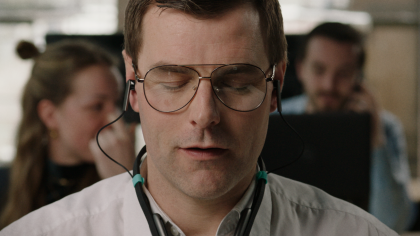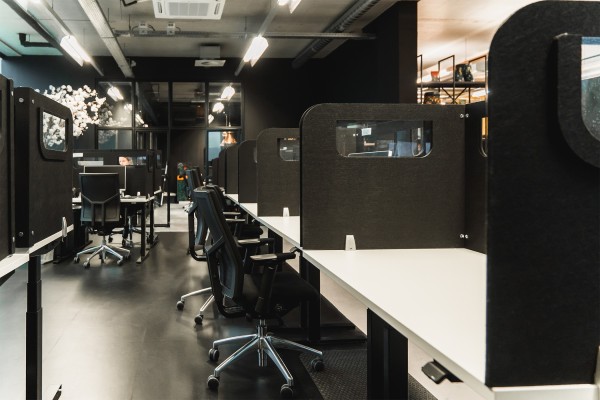Our solutions
Back
Sounds in professional practice
Sound is all around us, both indoors and outdoors. In this article we will emphasise indoor noise nuisance. In buildings such as offices, hospitals and restaurants and in public spaces, people often experience noise nuisance. We are sure you can remember an occasion on which you did.
We experience various types of noise nuisance
If the sounds we hear are loud, or too loud, they can be quite annoying, especially when the noise continues for a considerable period of time. If you can hear the conversations that are being held around you, your ability to focus on your work may be negatively affected.
While waiting for our turn to be served at a place with counters or service desks – let’s say, at the town hall or at a chemist’s – we can often hear the conversations around us. There is a lack of what could be called speech privacy in such situations.
And, of course, we are all familiar with situations in restaurants where having a proper conversation is hardly possible. Due to the loudness of the ambient noise, people can barely hear themselves talk, let alone their conversation partner. However, in theatres the level of speech intelligibility must be high, so as to ensure that all people, not only in the front but also in back seats, can properly hear the actors.
While waiting for our turn to be served at a place with counters or service desks – let’s say, at the town hall or at a chemist’s – we can often hear the conversations around us. There is a lack of what could be called speech privacy in such situations.
And, of course, we are all familiar with situations in restaurants where having a proper conversation is hardly possible. Due to the loudness of the ambient noise, people can barely hear themselves talk, let alone their conversation partner. However, in theatres the level of speech intelligibility must be high, so as to ensure that all people, not only in the front but also in back seats, can properly hear the actors.
Open-plan offices
Noise nuisance is also very common in large open-plan offices. In such spaces speech intelligibility tends to be good – often, too good. There is generally a lack of speech privacy.
Is noise nuisance a new thing? No. In the early twentieth century, the physicist Etienne Lombard already determined that speech intelligibility is negatively affected in a large room when several people are talking at once. This is called the Lombard effect, also known as the cocktail party effect.
Did people not experience noise nuisance in the past? They certainly did. However, in the old days, our behaviour tended to be less exuberant. People made fewer phone calls and there were far fewer audio-visual sounds (if any). Most of the noise produced was mechanical. We no longer notice many mechanical sounds. The human voice now plays a more prominent part in the noise nuisance we experience in buildings.
Is noise nuisance a new thing? No. In the early twentieth century, the physicist Etienne Lombard already determined that speech intelligibility is negatively affected in a large room when several people are talking at once. This is called the Lombard effect, also known as the cocktail party effect.
Did people not experience noise nuisance in the past? They certainly did. However, in the old days, our behaviour tended to be less exuberant. People made fewer phone calls and there were far fewer audio-visual sounds (if any). Most of the noise produced was mechanical. We no longer notice many mechanical sounds. The human voice now plays a more prominent part in the noise nuisance we experience in buildings.

How to combat noise nuisance
The results of a quick internet search allow us to choose one of countless acoustic products. But how to determine which product will actually solve our noise issues?
First we will have to determine the nature of the noise issue. Are we dealing with a space that is considered ‘loud’, or is the issue caused by impaired speech intelligibility in a large room? Or is this a closed concentration situation, and/or a meeting room in which sounds both from within and from without can still be heard?
When choosing products, we often (too often?) add random elements to our rooms, thinking that they will provide a solution. Our choice is often determined by the look, colour and price tag (obviously) of the product.
In many cases, noise nuisance issues can be attributed to the design of the room. Open-plan offices housing many or too many employees are very likely to generate noise nuisance.
This contains specific guidelines, e.g. do not let more than four to eight employees share a room. It also expresses the acoustic quality of a room in terms of reverberation time, and lists various insulation values for partitions between various types of rooms.
Tip: we would like to refer you to a so-called TED talk by Julian Treasure, in which he explains what noise nuisance is and calls on people to pay more attention to noise levels by adjusting their viewpoints and particularly their designs: ‘we must design more with our ears, rather than with our eyes'.
First we will have to determine the nature of the noise issue. Are we dealing with a space that is considered ‘loud’, or is the issue caused by impaired speech intelligibility in a large room? Or is this a closed concentration situation, and/or a meeting room in which sounds both from within and from without can still be heard?
When choosing products, we often (too often?) add random elements to our rooms, thinking that they will provide a solution. Our choice is often determined by the look, colour and price tag (obviously) of the product.
In many cases, noise nuisance issues can be attributed to the design of the room. Open-plan offices housing many or too many employees are very likely to generate noise nuisance.
This contains specific guidelines, e.g. do not let more than four to eight employees share a room. It also expresses the acoustic quality of a room in terms of reverberation time, and lists various insulation values for partitions between various types of rooms.
Tip: we would like to refer you to a so-called TED talk by Julian Treasure, in which he explains what noise nuisance is and calls on people to pay more attention to noise levels by adjusting their viewpoints and particularly their designs: ‘we must design more with our ears, rather than with our eyes'.
No half-measures
Noise nuisance has a considerable impact on employees. It may ultimately affect the organisation as a whole, if timely and appropriate measures are not taken.
Avoid half-measures that will not result in clearly discernible improvement. We recommend seeking an expert’s advice, including a sound level measurement. The expert can then determine what measures are required, and how many of them, to arrive at a solution to your noise issue. If large spaces are involved, the recommended solutions will not just involve noise absorption materials, but also sound barriers. Such barriers will ensure that sounds cannot spread across the room. Where smaller rooms are concerned, experts will generally recommend incorporating measures into the design that match the number of employees using the room and the nature of the activities for which the room is intended.
Our BE Safety Screens will provide comfortable acoustics in a room for employees who spend a great deal of time talking on the telephone and to others.
Noise nuisance has a considerable impact on employees. It may ultimately affect the organisation as a whole, if timely and appropriate measures are not taken.
Avoid half-measures that will not result in clearly discernible improvement. We recommend seeking an expert’s advice, including a sound level measurement. The expert can then determine what measures are required, and how many of them, to arrive at a solution to your noise issue. If large spaces are involved, the recommended solutions will not just involve noise absorption materials, but also sound barriers. Such barriers will ensure that sounds cannot spread across the room. Where smaller rooms are concerned, experts will generally recommend incorporating measures into the design that match the number of employees using the room and the nature of the activities for which the room is intended.
Our BE Safety Screens will provide comfortable acoustics in a room for employees who spend a great deal of time talking on the telephone and to others.
In brief:
- determine the nature of the problem (analysis and/or measurement);
- get an expert’s opinion;
- determine the acoustic specifications of certain products;
- do not just think in terms of measures to be taken, but consider reorganising things as well;
- determine your budget for the improvements.
Need help? We're here for you
Look at our FAQ or contact us
Many customers preceded you
Read about their experience with BakkerElkhuizen
Select your country and language





